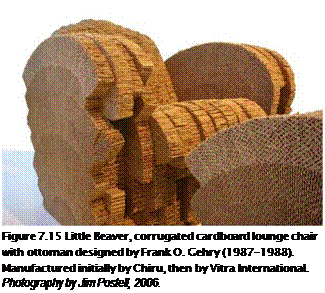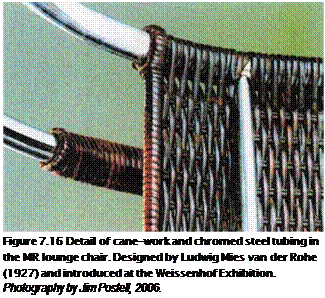The compressive and tensile strengths of materials are related but distinct in their performance capabilities. Compressive strength is the ability of material to resist compressive forces (pushing), while tensile strength is the material’s ability to resist tensile forces (pulling). Wood performs well in both compression and tension parallel to the grain, but when pulled at a right angle to the grain, it will split. Wood does not strongly resist shear forces applied along its grain, making it relatively easy to split with an axe or a chisel. Concrete performs well in compression but poorly in tension. Steel has excellent tensile and compressive strength, making it an ideal choice for the structural frame in Anders Hermansen’s Wire Sketch 1 chair designed in 1985 (Figure 7.13), and Poul Kjsrholm’s folded spring steel frame in PK 25, designed in 1951 (Figure 7.14).
|
|
 Figure 7.14 Continuous-folded, spring steel frame for PK 25 designed by Poul Kjsrholm (1951) while he was a stu – Figure 7.13 Wire Sketch 1 chair, designed by Anders Hermansen (1985). dent at the furniture department of the School of Arts and Made of 5-mm black painted steel. Photography by Jim Postell, 2006. Crafts in Denmark. Photography by Jim Postell, 2006.
Figure 7.14 Continuous-folded, spring steel frame for PK 25 designed by Poul Kjsrholm (1951) while he was a stu – Figure 7.13 Wire Sketch 1 chair, designed by Anders Hermansen (1985). dent at the furniture department of the School of Arts and Made of 5-mm black painted steel. Photography by Jim Postell, 2006. Crafts in Denmark. Photography by Jim Postell, 2006.
Density

 Density is the weight of a material relative to its volume or mass. Brazilian cherry wood is a dense tropical hardwood that has a beautiful grain figure. Paper is a lightweight material and is relatively warm to the touch. It is the primary material in the laminated corrugated cardboard Little Beaver lounge chair, designed by Frank O. Gehry (Figure 7.15). The concept of using an inexpensive material to create a beautiful object, especially one warm to the touch, was the start of a democratic ideology in furniture design using a material so familiar and accessible to everyone.
Density is the weight of a material relative to its volume or mass. Brazilian cherry wood is a dense tropical hardwood that has a beautiful grain figure. Paper is a lightweight material and is relatively warm to the touch. It is the primary material in the laminated corrugated cardboard Little Beaver lounge chair, designed by Frank O. Gehry (Figure 7.15). The concept of using an inexpensive material to create a beautiful object, especially one warm to the touch, was the start of a democratic ideology in furniture design using a material so familiar and accessible to everyone.
The tubular steel frame chairs by the early modernists Mart Stam, Marcel Breuer, and Ludwig Mies van der Rohe were cool to the touch, with carefully placed leather, fabric, or caning wherever the chair came into contact with the body (Figures 7.16 and 7.17). Dense materials such as metals tend to conduct heat away from the body, resulting in the sensation of coolness to the touch.
The sensation of cool or warm materials is one consideration in furniture design that influences the haptic sensation (tactile experience) of furniture. Consider the apparent temperature of an aluminum chair in the same room as a wood chair. Metals, glass, and ceramics are heat-conductive materials. They feel relatively cooler than non-heat-conductive materials under the same environmental conditions. Thermal conductivity is a measure of the rate at which heat is transferred through a material and is generally related to density. Denser materials like concrete conduct heat away 15 times faster than wood; steel conducts heat away 300 times faster than wood.2



